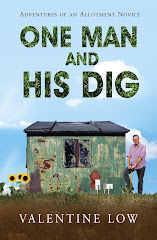
This is no ordinary shed. It may bear a passing resemblance to the sort of construction which can be found on allotments up and down the country, but there is much more to it than that. It is in fact, Art. It has been created by the chap on the right here, Thomas Pausz, an MA student at the Royal College of Art in London, and is meant to be a recreation of the community shed at the Manor Gardens allotments in Hackney Wick, the ones that were bulldozed to make way for the 2012 Olympics.
Thomas - who has lived in this country for 10 years, but was born in Paris to a Polish father and Breton mother - made it as his contribution to the college's design and architecture interim show. It is about shared memories, collective experience, and the political and social aspects of shed life (You didn't realise there were political aspects to shed life? Where have you been?).
The story about how Thomas came to build it is quite interesting. He lives in Hackney, and likes cycling around the area. One day he chanced upon the Manor Gardens site, and decided to have a look round. After a while he tried to leave, only to discover that he had been locked in. So he then spent the next hour or so having a really good explore, and was overwhelmed by the profusion of sheds there (and indeed anyone who knew the site would agree that they had some pretty good sheds). "I was completely amazed," he said. Finally he left, by climbing over the fence.
Funnily enough, when he came to do his project, he realised that the one shed he had not discovered was the community shed. He turned that omission into a virtue, by deliberately avoiding any photographs of the old shed, and instead re-created it by asking plot-holders what it looked like. They all had quite different memories; one recalled there being a photograph of the Queen inside, while another swore blind it was decorated with a picture of a Page 3 girl. Easy to confuse the two, I suppose. His technique explains why his shed - which is currently on view outside the Royal College of Art, next to the Royal Albert Hall - is not an exact replica of the original. I saw it the morning before it was completed, and told Thomas that I thought the original had more carpet, and more comfy chairs. (It was very well appointed, the Manor Gardens shed).
Meanwhile the evicted plotholders are trying to settle into their new home, on a specially constructed site in nearby Leyton. They are not having a very good time of it. Julie Sumner, who led the campaign against eviction, told me: "It is like a prisoner of war camp, built by B&Q. It is very sparse and bleak and regimented. Because it is very open it is much more windswept than our previous one. Also the soil is not draining properly, and we are standing in water half the time. They [the London Development Agency, responsible for bringing the Olympics to London and kicking out the Manor Gardens plotholders] spend £1.5 million in building these new allotments and they cannot even get it right. It does not give you a lot of confidence in them, does it?"


2 comments:
Living outside of London, I've tried to avoid reading or watching anything about the Olympics, that ghastly overblown drugfest that is sucking funds out of the rest of the country. So I've only just come across the story - the tragedy - of the Manor Road Allotments, their destruction and the faecical saga of their relocation. What a story of greed, incompetence and hypocrisy! As an ex-allotment holder (till the arthritis did for my knees) my heart goes out to this small, dispossessed community. Britain moves daily closer to a Stalinist state, all I can say is, thank god I'm old.
I'm impressed by Thomas's recreation of the community shed. I made a series of photographs of some 40+ sheds on the allotments for a course project I did just prior to the eviction. They are viewable at www.peterhoare.co.uk and I'm trying to find locations willing to host a show of the pictures (libraries, halls, pubs, galleries, etc) in order to educate/inform people who don't know, what a massively unjust decision it was to destroy such a viable and valuable social and practical resource.
Post a Comment